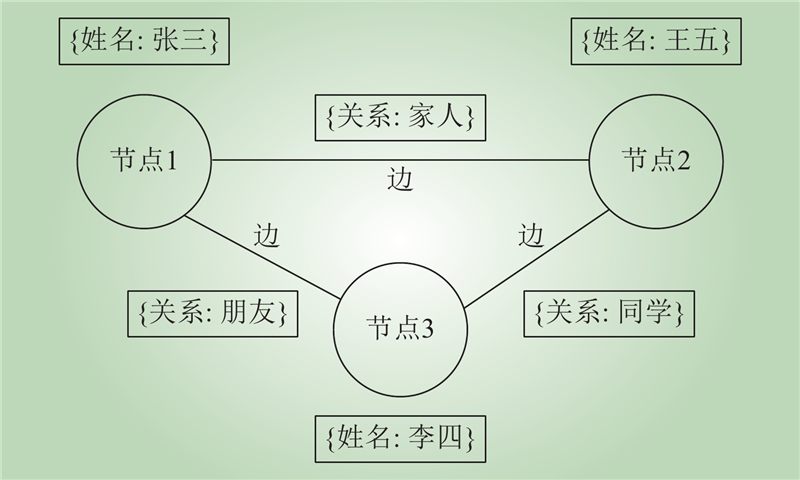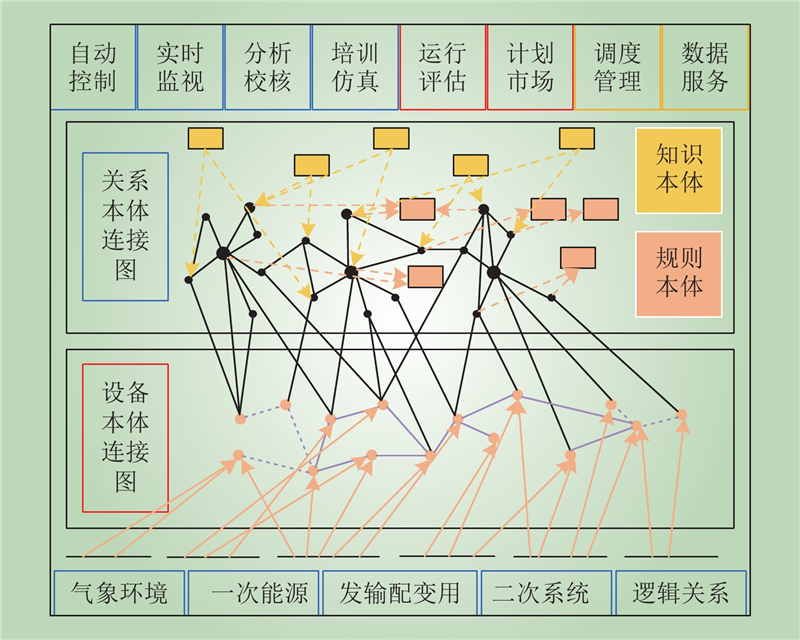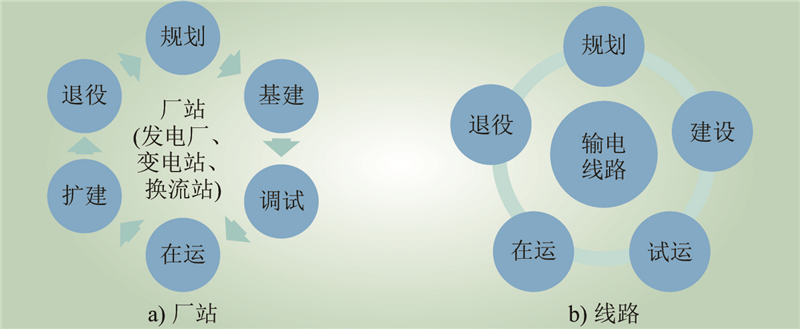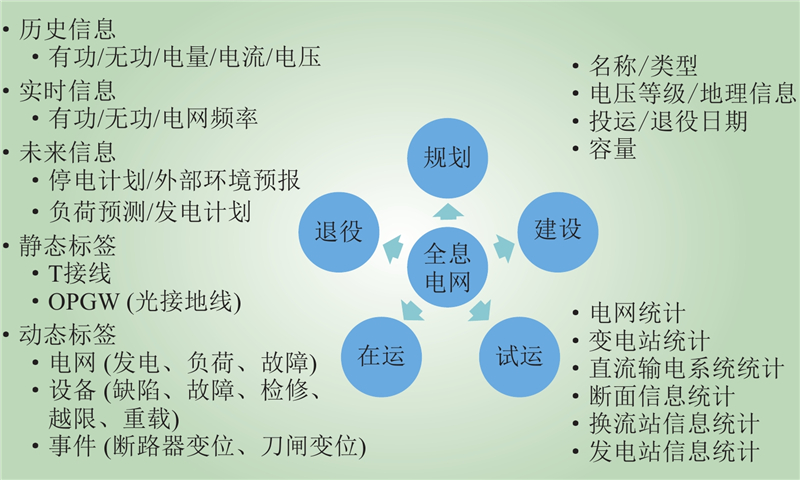| 1 |
许洪强, 姚建国, 南贵林, 等. 未来电网调度控制系统应用功能的新特征[J]. 电力系统自动化, 2018, 42 (1): 1- 7.
DOI
|
|
XU Hongqiang, YAO Jianguo, NAN Guilin, et al. New features of application function for future dispatching and control systems[J]. Automation of Electric Power Systems, 2018, 42 (1): 1- 7.
DOI
|
| 2 |
TANG Y C, LIU T T, LIU G Y, et al. Enhancement of power equipment management using knowledge graph[C]//2019 IEEE Innovative Smart Grid Technologies - Asia (ISGT Asia). Chengdu, China. IEEE, 2019: 905-910.
|
| 3 |
王臻, 刘东, 徐重酉, 等. 新型电力系统多源异构数据融合技术研究现状及展望[J]. 中国电力, 2023, 56 (4): 1- 15.
|
|
WANG Zhen, LIU Dong, XU Chongyou, et al. Status quo and prospect of multi-source heterogeneous data fusion technology for new power system[J]. Electric Power, 2023, 56 (4): 1- 15.
|
| 4 |
刘广一, 戴仁昶, 路轶, 等. 基于图计算的能量管理系统实时网络分析应用研发[J]. 电工技术学报, 2020, 35 (11): 2339- 2348.
|
|
LIU Guangyi, DAI Renchang, LU Yi, et al. Graph computing based power network analysis applications[J]. Transactions of China Electrotechnical Society, 2020, 35 (11): 2339- 2348.
|
| 5 |
罗宾逊 I, 韦伯 J, 艾弗雷姆 E. 图数据库[M]. 刘璐, 梁越, 译. 北京: 人民邮电出版社, 2015: 2-3.
|
| 6 |
鄂海红, 韩鹏昊, 宋美娜. 关系型数据库向图数据库的转换方法[J]. 计算机科学, 2021, 48 (10): 140- 144.
DOI
|
|
E Haihong, HAN Penghao, SONG Meina. Conversion method from relational database to graph database[J]. Computer Science, 2021, 48 (10): 140- 144.
DOI
|
| 7 |
刘宇宁, 范冰冰. 图数据库发展综述[J]. 计算机系统应用, 2022, 31 (8): 1- 16.
|
|
LIU Yuning, FAN Bingbing. Survey on graph database development[J]. Computer Systems and Applications, 2022, 31 (8): 1- 16.
|
| 8 |
LIU G Y, LIU K W, SHI D, et al. Graph computation and its applications in smart grid[C]//2017 IEEE International Congress on Big Data (BigData Congress). Honolulu, HI, USA. IEEE, 2017: 507–510.
|
| 9 |
NAI L F, XIA Y L, TANASE I G, et al. GraphBIG: understanding graph computing in the context of industrial solutions[C]//Proceedings of the International Conference for High Performance Computing, Networking, Storage and Analysis. Austin Texas. ACM, 2015: 1–12.
|
| 10 |
刘广一, 王继业, 李洋, 等. “电网一张图” 时空信息管理系统[J]. 电力信息与通信技术, 2020, 18 (1): 7- 17.
|
|
LIU Guangyi, WANG Jiye, LI Yang, et al. "one graph of power grid" spatio-temporal information management system[J]. Electric Power Information and Communication Technology, 2020, 18 (1): 7- 17.
|
| 11 |
路轶, 汤亚宸, 刘广一, 等. 基于“电网一张图” 的时空数据管理系统[J]. 供用电, 2019, 36 (11): 12- 19.
|
|
LU Yi, TANG Yachen, LIU Guangyi, et al. Spatiotemporal data management system based on "one graph of power grid"[J]. Distribution & Utilization, 2019, 36 (11): 12- 19.
|
| 12 |
张冰雪, 刘婷婷, 汤亚宸, 等. 基于图数据库的电力设备全生命周期管理技术研究[J]. 电力信息与通信技术, 2019, 17 (3): 1- 7.
|
|
ZHANG Bingxue, LIU Tingting, TANG Yachen, et al. Research on power equipment life-cycle management technology based on graph database[J]. Electric Power Information and Communication Technology, 2019, 17 (3): 1- 7.
|
| 13 |
汤亚宸, 方定江, 韩海韵, 等. 基于图数据库和知识图谱的电力设备质量综合管理系统研究[J]. 供用电, 2019, 36 (11): 35- 40.
|
|
TANG Yachen, FANG Dingjiang, HAN Haiyun, et al. Research on power equipment quality integrated management system based on graph database and knowledge graph[J]. Distribution & Utilization, 2019, 36 (11): 35- 40.
|
| 14 |
刘广一, 戴仁昶, 路轶, 等. 电力图计算平台及其在能源互联网中的应用[J]. 电网技术, 2021, 45 (6): 2051- 2063.
|
|
LIU Guangyi, DAI Renchang, LU Yi, et al. Electric power graph computing platform and its application in energy Internet[J]. Power System Technology, 2021, 45 (6): 2051- 2063.
|
| 15 |
邹文仲, 邓力源, 张高峰, 等. 基于调度云平台通用分布式架构实践[J]. 南方电网技术, 2023, 17 (9): 20- 28.
|
|
ZOU Wenzhong, DENG Liyuan, ZHANG Gaofeng, et al. Practice of general distributed architecture based on scheduling cloud platform[J]. Southern Power System Technology, 2023, 17 (9): 20- 28.
|
| 16 |
ZHOU Z X, YUAN C, YAO Z Y, et al. CIM/E oriented graph database model architecture and parallel network topology processing[C]//2018 IEEE Power & Energy Society General Meeting (PESGM). Portland, OR. IEEE, 2018: 1–5.
|
| 17 |
DAI J P, YAO Z Y, ZHANG G F, et al. Graph computing-based real-time network topology analysis for power system[C]//2019 IEEE Power & Energy Society General Meeting (PESGM). Atlanta, GA, USA. IEEE, 2019: 1–5.
|
| 18 |
陈政, 张俊勃, 陈戈, 等. 基于RedisGraph的电网CIM/XML数据模型构建与应用[J]. 电力信息与通信技术, 2022, 20 (4): 1- 8.
|
|
CHEN Zheng, ZHANG Junbo, CHEN Ge, et al. Construction and application of CIM/XML of power grid based on RedisGraph[J]. Electric Power Information and Communication Technology, 2022, 20 (4): 1- 8.
|
| 19 |
YUAN C, ZHOU Y Q, ZHANG G F, et al. Exploration of graph computing in power system state estimation[C]//2018 IEEE Power & Energy Society General Meeting (PESGM). Portland, OR. IEEE, 2018: 1–5.
|
| 20 |
YUAN C, ZHOU Y Q, LIU G Y, et al. Graph computing-based WLS fast decoupled state estimation[J]. IEEE Transactions on Smart Grid, 2020, 11 (3): 2440- 2451.
DOI
|
| 21 |
LU Y, YUAN C, ZHANG X, et al. Graph Computing based Distributed State Estimation with PMUs[C]//2020 IEEE Power & Energy Society General Meeting (PESGM). Montreal, QC, Canada. IEEE, 2020: 1–5.
|
| 22 |
YUAN C, LU Y, FENG W, et al. Graph computing based distributed fast decoupled power flow analysis[C]//2019 IEEE Power & Energy Society General Meeting (PESGM). Atlanta, GA, USA. IEEE, 2019: 1–5.
|
| 23 |
刘克文, 张国芳, 袁琛, 等. 基于图计算的快速非线性迭代法求解潮流计算[J]. 电力信息与通信技术, 2018, 16 (10): 19- 24.
|
|
LIU Kewen, ZHANG Guofang, YUAN Chen, et al. Fast nonlinear iterative method based on graph calculation for power flow calculation[J]. Electric Power Information and Communication Technology, 2018, 16 (10): 19- 24.
|
| 24 |
FENG W, YUAN C, DAI R C, et al. Graph Computation based Power Flow for large-scale AC/DC system[C]//2018 International Conference on Power System Technology (POWERCON). Guangzhou. IEEE, 2018: 468–473.
|
| 25 |
FENG W, YUAN C, SHI Q X, et al. Graph computing based distributed parallel power flow for AC/DC systems with improved initial estimate[J]. Journal of Modern Power Systems and Clean Energy, 2021, 9 (2): 253- 263.
DOI
|
| 26 |
YUAN C, LU Y, LIU K W, et al. Exploration of bi-level PageRank algorithm for power flow analysis using graph database[C]//2018 IEEE International Congress on Big Data (Big Data Congress). San Francisco, CA. IEEE, 2018: 143–149.
|
| 27 |
YUAN C, LIU G Y, DAI R C, et al. Power flow analysis using graph based combination of iterative methods and vertex contraction approach[C]//2018 International Conference on Power System Technology (POWERCON). Guangzhou. IEEE, 2018: 4480–4487.
|
| 28 |
ZHAO Y T, YUAN C, LI S, et al. Graph computing based fast screening in contingency analysis[C]//2019 IEEE Innovative Smart Grid Technologies - Asia (ISGT Asia). Chengdu, China. IEEE, 2019: 667–672.
|
| 29 |
ZHAO Y T, YUAN C, LIU G Y, et al. Graph-based preconditioning conjugate gradient algorithm for "N-1" contingency analysis[C]//2018 IEEE Power & Energy Society General Meeting (PESGM). Portland, OR. IEEE, 2018: 1–5.
|
| 30 |
MITCHELL-COLGAN E, WU J J, ZHAO Y T, et al. Symbolic factorization re-utilization for contingency analysis[C]//2018 IEEE Power & Energy Society General Meeting (PESGM). Portland, OR. IEEE, 2018: 1–5.
|
| 31 |
尚亚彬, 王小君, 刘曌, 等. 考虑海量异质资源分区聚类的输配电网协同调度策略[J]. 电力系统保护与控制, 2024, 52 (22): 82- 92.
|
|
SHANG Yabin, WANG Xiaojun, LIU Zhao, et al. Cooperative scheduling strategy for transmission and distribution networks considering partitioned clustering of massive heterogeneous resources[J]. Power System Protection and Control, 2024, 52 (22): 82- 92.
|
| 32 |
郭庆来, 兰健, 周艳真, 等. 基于混合智能的新型电力系统运行方式分析决策架构及其关键技术[J]. 中国电力, 2023, 56 (9): 1- 13.
|
|
GUO Qinglai, LAN Jian, ZHOU Yanzhen, et al. Architecture and key technologies of hybrid-intelligence-based decision-making of operation modes for new type power systems[J]. Electric Power, 2023, 56 (9): 1- 13.
|
| 33 |
邱明石, 陈俊儒, 刘牧阳, 等. 考虑纳网系统和微网运营商电价机制的主从博弈优化调度策略[J]. 电力系统保护与控制, 2024, 52 (19): 15- 34.
|
|
QIU Mingshi, CHEN Junru, LIU Muyang, et al. A master-slave game optimization scheduling strategy considering the electricity pricin mechanism of nanogrid systems and microgrid operators[J]. Power System Protection and Control, 2024, 52 (19): 15- 34.
|
| 34 |
马智刚, 卫志农, 陈胜, 等. 基于图计算的交直流混合配电网优化调度[J]. 电力系统自动化, 2023, 47 (18): 161- 170.
DOI
|
|
MA Zhigang, WEI Zhinong, CHEN Sheng, et al. Optimal dispatch of AC/DC hybrid distribution network based on graph computing[J]. Automation of Electric Power Systems, 2023, 47 (18): 161- 170.
DOI
|
| 35 |
韩赫, 张沛超, 柴博, 等. 基于图计算的区域热电系统建模与运行优化方法[J]. 中国电机工程学报, 2022, 42 (19): 7113- 7126.
|
|
HAN He, ZHANG Peichao, CHAI Bo, et al. Modeling and operational optimization methods for district heat-electricity systems based on graph computing[J]. Proceedings of the CSEE, 2022, 42 (19): 7113- 7126.
|
| 36 |
CHEN T, YUAN C, LIU G Y, et al. Graph based platform for electricity market study, education and training[C]//2018 IEEE Power & Energy Society General Meeting (PESGM). Portland, OR. IEEE, 2018: 1–5.
|
| 37 |
WEI L F, LIU G Y, TAN J, et al. GraphVPP: enabling optimal bidding strategy of virtual power plants in graph computing frameworks[C]//2020 IEEE Power & Energy Society General Meeting (PESGM). Montreal, QC, Canada. IEEE, 2020: 1–5.
|
| 38 |
KHODAYAR M E, SHAHIDEHPOUR M, WU L. Enhancing the dispatchability of variable wind generation by coordination with pumped-storage hydro units in stochastic power systems[J]. IEEE Transactions on Power Systems, 2013, 28 (3): 2808- 2818.
DOI
|






